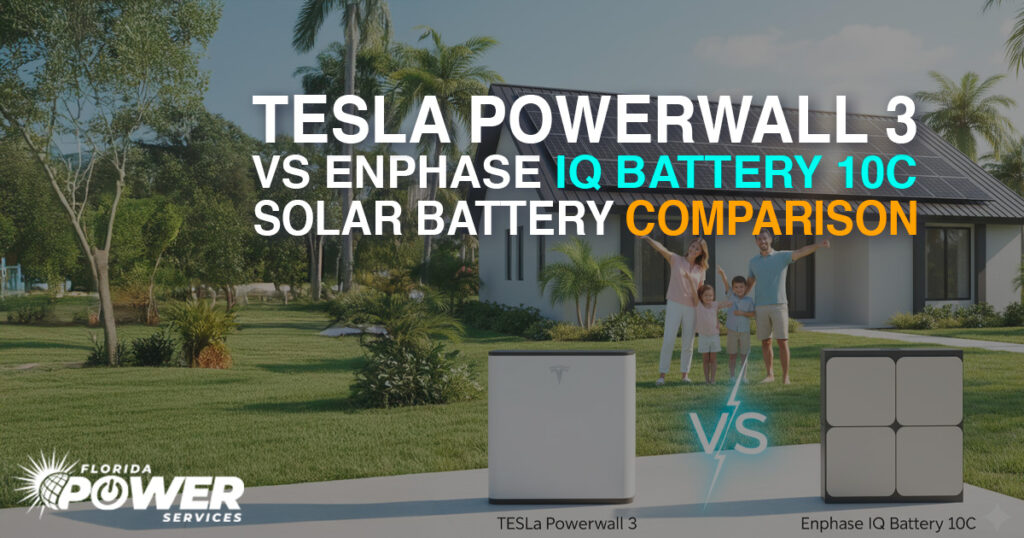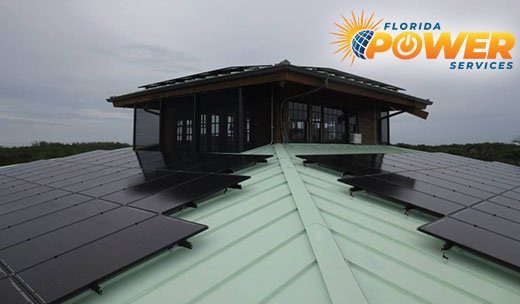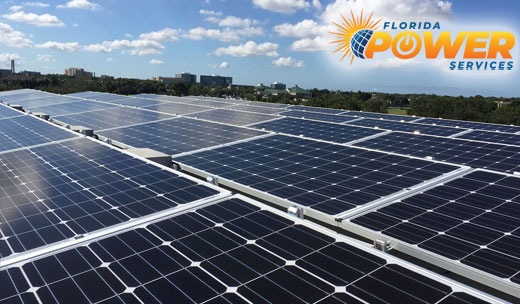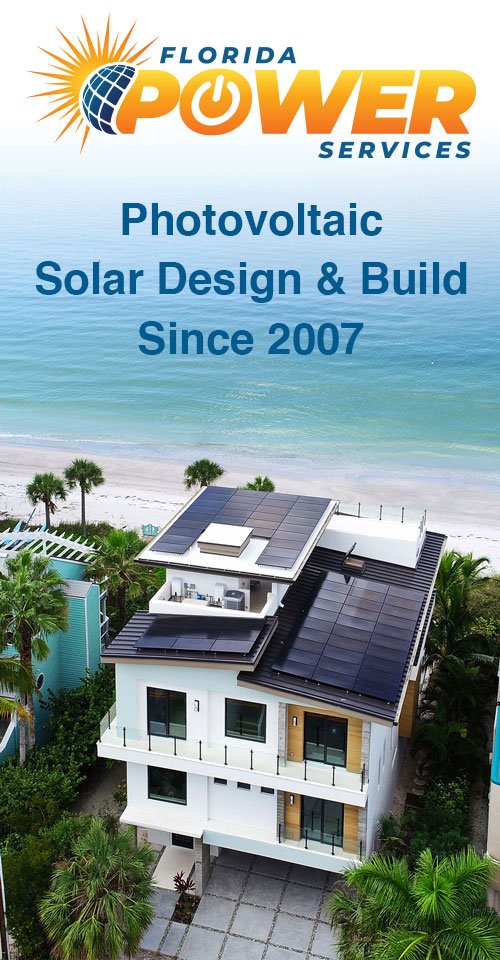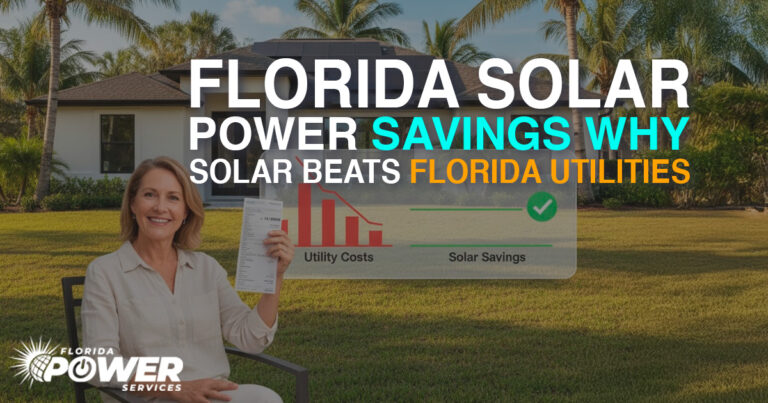🌴Why This Comparison Matters in Florida
Florida homeowners face unique challenges: hurricanes, frequent outages, and sweltering summer heat. Solar panels help reduce bills, but they only generate energy while the sun is shining. Batteries, on the other hand, store that energy so your home stays powered when the grid goes down.
When comparing the Tesla Powerwall 3 vs Enphase IQ Battery 10C, the differences matter more in Florida than almost anywhere else. Backup power during storm season, reliable surge handling for heavy AC loads, and system scalability can mean the difference between peace of mind and unexpected blackouts.
With the30% Federal Clean Energy Credit plus the 10% Domestic Content Adder (DCA) expiring on December 31, 2025, the decision between Tesla Powerwall 3 vs Enphase IQ Battery 10C impacts not only reliability but also your long-term financial return.
⚡ Core Specs at a Glance (Amps @ 240 V)
Here’s how the Tesla Powerwall 3 vs Enphase IQ Battery 10C specs compare side by side:
| Feature | Tesla Powerwall 3 | Enphase IQ Battery 10C |
| Usable Capacity | 13.5 kWh | 10.0 kWh |
| Continuous Output | 48 A | 29.5 A |
| Peak Output (3 sec) | Not published | 56 A |
| Peak Output (10 sec) | Not published | 44.8 A |
| Locked-Rotor Amps (LRA) | ~185 A (<1 sec) | 90 A for ~2 sec with Power Start™ |
| Chemistry | Lithium Iron Phosphate (LFP) | Lithium Iron Phosphate (LFP) |
| Inverter Type | Built-in string inverter (11.5 kW AC) | Distributed microinverters (IQ8 per panel + 4 per battery) |
| System Control | Tesla Gateway (10-year warranty) | IQ Combiner 6C (15-year warranty) |
| Generator Support | ❌ No | ✅ Yes |
| Federal Clean Energy Credit | ✅ 30% | ✅ 30% |
| Domestic Content Adder (DCA) | ❌ No | ✅ 10% (when project qualifies) |
🔄 Modularity & Stacking
Tesla Powerwall 3
- Each unit delivers 48 A continuous at 240 V (11.5 kW).
- Up to 4 full units can be installed for 192 A continuous output and 54 kWh of storage.
- Up to 3 Expansion Units (13.5 kWh each, no inverter) can be added, raising storage to 94.5 kWh.
- Expansions add runtime only, not additional power.
Enphase IQ Battery 10C
- Each unit delivers 29.5 A continuous at 240 V (7.08 kW).
- Scales in 10 kWh increments up to 8 units = 236 A continuous output and 80 kWh storage.
- Each battery includes four integrated microinverters, so both storage and output scale together.
👉 The Tesla Powerwall 3 vs Enphase IQ Battery 10C comparison highlights Tesla’s strength per unit, but Enphase scales further for whole-home backup in Florida.
⚡ Surge & Startup Loads
Florida homes often run multiple heavy loads like AC units, refrigerators, and pool pumps. These require strong surge capacity.
Tesla Powerwall 3
- Continuous: 48 A
- Surge: ~185 A locked-rotor amps, but only for less than 1 second
- ❌ No published 3- or 10-second surge specs
Enphase IQ Battery 10C
- Continuous: 29.5 A
- 56 A for 3 seconds
- 44.8 A for 10 seconds
- Power Start™ delivers 90 A for ~2 seconds to start motors and compressors
👉 In real-world conditions, Tesla Powerwall 3 vs Enphase IQ Battery 10C shows Enphase is engineered to handle Florida’s AC-heavy homes better.
🔌 Reliability & Generator Support
Tesla Powerwall 3
- Centralized string inverter. If it fails, the entire system shuts down.
- ❌ No generator support. If your batteries are empty, the generator can power loads but cannot recharge Tesla batteries.
Enphase IQ Battery 10C
- Distributed microinverters. If one fails, the rest keep operating.
- ✅ Full generator integration with the IQ Combiner 6C. The generator can power loads and recharge batteries during long outages.
👉 In Florida’s hurricane-prone climate, this flexibility is crucial. A generator might only need to run two hours to recharge the battery bank, then shut off while your home quietly runs on stored power.
🔒 Safety
Both batteries use Lithium Iron Phosphate (LFP) chemistry:
- Safer, with no thermal runaway risk
- Longer lifespan with higher cycle counts
- Cobalt-free, making them more sustainable
In the Tesla Powerwall 3 vs Enphase IQ Battery 10C discussion, safety is even. Both use LFP chemistry, which is the best choice for Florida’s hot and humid climate.
📱 Ease of Use & Visibility
Tesla
- Sleek app design
- ❌ No panel-level monitoring
- Managed as one string, so shading on one panel affects the whole system
- Requires manual reset after overloads
Enphase
- Each panel has its own IQ8 microinverter for module-level optimization
- ✅ Real-time monitoring of every panel
- Decentralized storage system with four microinverters per battery
- Auto-reset feature for overloads
👉 For visibility and resilience, the Tesla Powerwall 3 vs Enphase IQ Battery 10C comparison is clear: Enphase offers superior monitoring and ease of use.
💡 What Batteries Actually Do (and Don’t Do)
- Solar panels lower your electric bill.
- Batteries store energy for outages.
In Florida, most utilities still offer 1:1 net metering, so solar alone can bring bills close to net-zero. Batteries add value by:
- Providing backup power during hurricanes
- Keeping solar active when the grid is out
- Offering resilience when paired with generators
👉 Solar = savings. Batteries = security.
💸 Incentives & ROI: Tesla Powerwall 3 vs Enphase IQ Battery 10C
Tesla Powerwall 3
- ✅ 30% Federal Clean Energy Credit
- ❌ Not eligible for the 10% DCA
Enphase IQ Battery 10C
- ✅ 30% Federal Clean Energy Credit
- ✅ 10% DCA when components qualify
💡 Example: On a $60,000 solar + battery project:
- Tesla = $18,000 back → Net cost $42,000
- Enphase = $24,000 back → Net cost $36,000
When comparing the Tesla Powerwall 3 vs Enphase IQ Battery 10C, that’s $6,000 more in savings with Enphase.
🛡️ Warranty Comparison
| Component | Tesla Powerwall 3 | Enphase IQ Battery 10C |
| Battery | 10 years, ≥70% capacity | 15 years / 6,000 cycles, ≥60% capacity |
| Inverter | 10 years | 25 years (microinverters inside each unit) |
| System Control | Tesla Gateway – 10 years | N/A (not required for 10C) |
| Combiner | N/A | IQ Combiner 6C – 15 years |
👉 Tesla offers 10 years across the board, while Enphase extends to 15–25 years, leading the industry.
🕐 Why You Shouldn’t Wait
Delaying the Tesla Powerwall 3 vs Enphase IQ Battery 10C decision carries risks:
- Federal incentives (40% combined) expire on December 31, 2025.
- Utility interconnection delays continue to grow.
- High-capacity batteries are already in limited supply.
- Florida’s hurricane seasons bring longer outages each year.
Acting now ensures savings, availability, and peace of mind.
✅ The Bottom Line
When comparing the Tesla Powerwall 3 vs Enphase IQ Battery 10C, the Enphase system comes out on top for Florida homeowners. Key advantages include:
- Scales higher, up to 236 A continuous at 240 V
- Handles surge loads with Power Start™
- Provides generator support with recharge capability
- Panel-level monitoring and auto-reset
- Longer warranties: 15 years on batteries, 25 years on inverters
- Eligible for both the 30% Federal Clean Energy Credit and the 10% DCA
📞 Secure Your Solar + Battery Savings Today
Florida Power Services has been designing and installing solar and battery systems since 2007. As a NABCEP-certified, state-licensed solar contractor, we specialize exclusively in solar.
Contact us today for your free quote. Lock in incentives, secure your panels, and make the right choice in the Tesla Powerwall 3 vs Enphase IQ Battery 10C comparison before the 2025 deadline.

